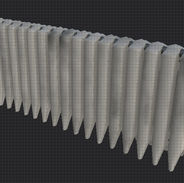Aaron Drew
My responsibilities for this project were creating a proxy layout, modeling, surfacing, and set dressing. I got a great chance to work with Unreal Engine for the first time and I feel like I have a better knowledge of the program now. Other programs I used were Maya and Substance Painter.
Proxy Layout


First, to give everyone in my project a reference for size and location, I created a proxy layout out of polycubes. I set up a camera in order to match the perspective of our Dishonored 2 reference picture. There was going to be a large number of assets to keep track of, so using this proxy as a reference would help us be accurate on scale and layout.
Modeling

I felt I had a good grasp of the dimension of the building, so I focused on modeling the building's architecture. The pillars were my favorite asset to model and were also the area I spent the most time on. Many objects in the scene have ridges and bevels that needed to translate into unreal, so I often exaggerated edges with the extrude and bevel tool in Maya. Each door has a cement frame attached to the wall trim and each window has a cement detail as well. Other assets such as a blackboard on the wall and carpets on the floor were also modeled.


The next model I created was the mailboxes on the wall. Each object by the window is the same objects stacked on top of each other in the mailbox room, the only difference is the large drawers on the bottom row of the window set. I would love to revisit this model at another time and translate some of the drawers to be slightly open, instead of them all being closed drawers. The dividing wall in the middle of the room was another object I created.

Here are some other assets I created. These models are going to be used while set-dressing the scene in Unreal Engine, so there will be many iterations of them across the room.
Texturing

The textures I created were for small objects scattered around the room. I used substance painter for all textures. The hardest aspect was creating the metal textures because they often imported strangely into Unreal Engine. I found out later that this error was because the roughness maps were importing as a "color" instead of a "mask." After fixing this the textures imported much better.
Set Dressing


After importing all assets and textures, the team finished lighting. The final step was to set dress the scene much like how the initial reference picture looked. I tried to fill every table with a unique set of models, reflecting how every worker's desk would look different in real life. I filled the bookshelves with objects, and also scattered various stacks of boxes around the room. The final product of this project is something I'm very proud of and never imagined I would learn this much knowledge in 3 weeks.









